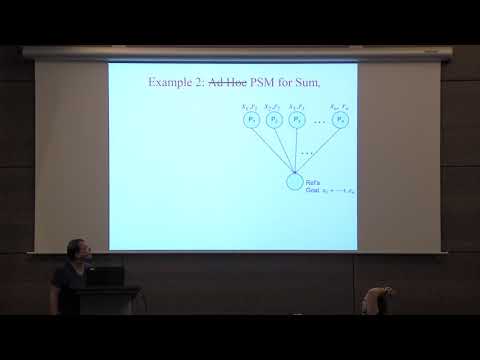Welcome to the resource topic for 2017/147
Title:
Ad Hoc PSM Protocols: Secure Computation Without Coordination
Authors: Amos Beimel, Yuval Ishai, Eyal Kushilevitz
Abstract:We study the notion of {\em ad hoc secure computation}, recently introduced by Beimel et al. (ITCS 2016), in the context of the {\em Private Simultaneous Messages} (PSM) model of Feige et al.\ (STOC 2004). In ad hoc secure computation we have n parties that may potentially participate in a protocol but, at the actual time of execution, only k of them, whose identity is {\em not} known in advance, actually participate. This situation is particularly challenging in the PSM setting, where protocols are non-interactive (a single message from each participating party to a special output party) and where the parties rely on pre-distributed, correlated randomness (that in the ad-hoc setting will have to take into account all possible sets of participants). We present several different constructions of \apsm\ protocols from standard PSM protocols. These constructions imply, in particular, that efficient information-theoretic \apsm\ protocols exist for NC1 and different classes of log-space computation, and efficient computationally-secure \apsm\ protocols for polynomial-time computable functions can be based on a one-way function. As an application, we obtain an information-theoretic implementation of {\em order-revealing encryption} whose security holds for two messages. We also consider the case where the actual number of participating parties t may be larger than the minimal k for which the protocol is designed to work. In this case, it is unavoidable that the output party learns the output corresponding to each subset of k out of the t participants. Therefore, a best possible security'' notion, requiring that this will be the {\em only} information that the output party learns, is needed. We present connections between this notion and the previously studied notion of {\em $t$-robust PSM} (also known as non-interactive MPC’‘). We show that constructions in this setting for even simple functions (like AND or threshold) can be translated into non-trivial instances of program obfuscation (such as {\em point function obfuscation} and {\em fuzzy point function obfuscation}, respectively). We view these results as a negative indication that protocols with ``best possible security’’ are impossible to realize efficiently in the information-theoretic setting or require strong assumptions in the computational setting.
ePrint: https://eprint.iacr.org/2017/147
Talk: https://www.youtube.com/watch?v=D_OcwSaIO4k
See all topics related to this paper.
Feel free to post resources that are related to this paper below.
Example resources include: implementations, explanation materials, talks, slides, links to previous discussions on other websites.
For more information, see the rules for Resource Topics .
